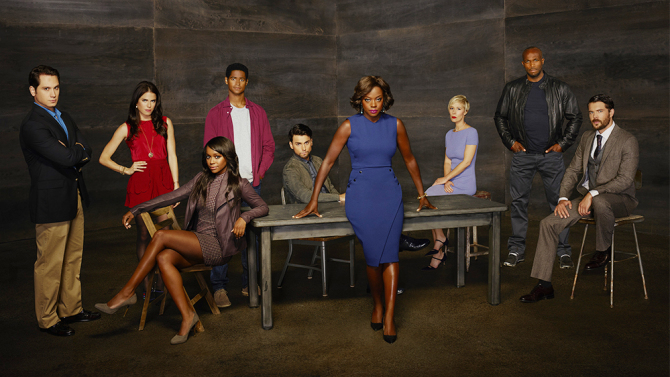by Sohum Pal
How to Get Away with Murder is one of ABC’s most popular shows–and for good reason. It is a “prestige drama” in every sense of the phrase: its characters inevitably embody wealth and privilege, if sometimes hard-earned; the primary plot device, training in the work of the law at a upper-tier university, embodies the bourgeois; the show functions on many layers, critiquing sexuality and relationships as easily as it does immigration, psychiatric care, and of course, criminal proceedings. Perhaps it best embodies the key trait of such dramas: that each of the main characters does something despicable—chopping up a body, manipulating a loved one, or something else in that vein—and we are still left rooting for them.
Yet HTGAWM, as it is often referred to on fan blogs and in popular criticism, falls flat where nearly each of its predecessors did. Its first season did little wrong: each episode felt carefully constructed, with dialogue and plot devices that constantly led the audience where it needed to be for the moment, before the plot twisted and thickened and left viewers to figure out where to next. It was constantly pushing the norms of what could be televised and what audiences were willing to watch: a brilliant Black law professor (played by the much-acclaimed Viola Davis), amazingly erotic gay and heterosexual sex scenes, and sometimes alarming implicit brutality. What happened next, as was inevitable, was the falling flat of subsequent seasons; having already shocked viewers and established its own boundaries, HTGAWM has boxed itself in and played safely within those boundaries. Repeated murders, incest, stalking, and sex cannot shock us—and yet, anything else would be out of character for the show. What the show needs now is humanity.
What we have seen thus far has been the work of superhumans–each of the characters has somehow wowed us with their brilliance in legal strategy or investigatory work or emotional manipulation. In the first season the Keating Five, those five law students Annalise Keating had selected to work at her firm, disposed of a body with a sort of manic energy and minimal psychological trauma. The second season offers more backstory on the characters, yet its own plotlines are thick with blood and an unsurprising interconnectedness. The third season has just begun, promising yet another heinous death and beginning with a recognition of the distrust that has formed between each of the characters. Yet viewers are forced to question the characters: can they be true to life? Or do they exist as legal superheroes outside the simultaneous twin constraints of reality and believability?
There is a pervading sense that Annalise Keating and her band of loyal disciples are eternally white-hats. They engage in morally dubious practices, but always in service of something greater than themselves–a mythologized sense of moral justice that fills the lacunae left by the legal system’s myriad failings. The problem of the white-hat/black-hat duality in television, of course, is that white-hats may not fail. They are intended to be infallible, even in the face of their own failings. Shonda Rhimes and her own band of writing and production staff have trapped themselves in established patterns of their own creation, and the remedy is not higher stakes or more anguished drama: the solution is humanity. In short, each of the deified characters—Connor, Wes, Annalise, Laurel, Michaela, Asher, and Oliver—must fall from their heavenly perches. And yet, this cannot be a dramatic fall, symbolized by anguished wailing in the woods—it must be a human fall, as the characters fall apart in the ways familiar to the mortal realm.
The third season has made an initial promise of humanity: we see that the five law students are at the bottom of their class–a consequence, we hope, of their extracurricular (and extralegal) activities, and the psychological trauma they must have suffered in the process. We see broken relationships, new and revived romances, and the beginnings of a professional anxieties. These are problems of the familiar to the common person, and promises that Annalise and the Keating Five have begun their humanizing fall from grace. It remains to be seen, in this season and its successors, whether these promises will be kept or (like the promises made throughout the show) broken in service of its false greater cause.


